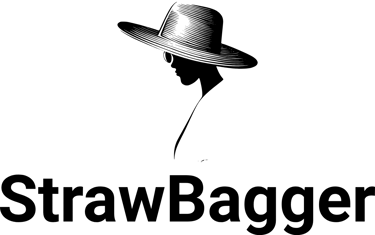Adopt a "strawbagger mindset!"

Deadstock
Deadstock: Its Benefits and Uses
Deadstock fabric refers to surplus or leftover textiles from mills and fashion houses that would otherwise go to waste. Repurposing these materials reduces landfill use and gives new life to existing resources.
Benefits:
Waste Reduction: Utilizes existing materials, minimizing environmental impact.
Unique Designs: Offers limited-edition fabrics for exclusive fashion pieces.
Cost-Effective: Often available at lower costs, benefiting both designers and consumers.
Supports Sustainable Practices: Encourages recycling and responsible consumption.
Uses:
Fashion items like dresses and jackets.
Accessories such as bags and scarves.
Home textiles, including cushions and curtains.
Source: (Sustainable Review)
Let's take a Closer Look at Deadstock
Deadstock as a Sustainable Fabric
1. What is Deadstock Fabric?
Deadstock fabric refers to leftover, surplus, or unused textiles from:
Fashion houses and garment factories
Textile mills and production overruns
Canceled orders or design changes
These fabrics are typically new and unused, but would otherwise go to landfills or incineration if not repurposed.
Sometimes also called "overstock", "mill ends", or "fabric waste", deadstock is repurposed by sustainable brands and independent designers.
2. Environmental Benefits
Reduces Textile Waste:
Diverts high-quality fabrics from landfills, helping combat the millions of tons of annual textile waste created by the fashion industry.
Avoids Additional Resource Use:
No new water, dyes, chemicals, or energy are used in producing the fabric—this makes deadstock one of the most resource-efficient materials.
Decreases Pollution and Carbon Emissions:
Prevents waste incineration, which emits harmful gases and particulates.
Minimizes the carbon footprint by eliminating the need for new raw material extraction and processing.
Utilizes What Already Exists:
Encourages a "use what we have" mindset in design, contributing to a circular economy.
3. Durability and Longevity
Deadstock fabric is often:
Of high commercial or designer-grade quality
Made to withstand garment production and retail wear
These are not damaged or second-rate materials—they're typically:
Overstock from large fashion productions
Rolls left unused due to color changes, fabric revisions, or forecasting errors
Because of this, garments made from deadstock often last as long as conventionally produced ones, if not longer.
4. Low-Waste Production
Deadstock-based production is inherently low-waste because it:
Uses existing materials instead of manufacturing new fabric
Encourages small-batch or made-to-order clothing, minimizing overproduction
Inspires creative use of limited yardage, often leading to more thoughtful and efficient designs
Designers working with deadstock often cut and produce garments with precision to avoid fabric waste.
5. Versatility and Comfort
Deadstock is incredibly versatile, as it can be made from:
Cotton, silk, linen, wool, viscose, polyester, denim, jersey, and more
This versatility makes it suitable for:
Everyday fashion
Luxury garments
Home goods and accessories
Since the fabrics were originally intended for mainstream production, they usually meet industry standards for softness, comfort, and performance.
6. Economic and Social Impact
Deadstock supports:
Small designers and slow fashion brands, who gain access to premium materials at a reduced cost
Ethical production models, as smaller quantities naturally discourage mass production
Waste-conscious consumers, who want one-of-a-kind or limited-edition pieces
It also opens the door to local manufacturing and upcycling startups, helping reshape the economic models of fashion around sustainability.
7. Circular Fashion and Deadstock
Deadstock fits neatly into the circular fashion movement by:
Extending the lifecycle of existing materials
Reducing dependency on new raw materials
Encouraging design-led sustainability
Many brands now focus exclusively on deadstock capsules or collections, emphasizing transparency and traceability.
It inspires consumer interest in slow fashion, storytelling, and limited-edition uniqueness.
8. Things to Consider
Limited Quantities:
Deadstock fabric is often only available in small batches—making mass production difficult or impossible
Once a roll is gone, it usually can’t be reordered
Lack of Transparency:
In some cases, the origin and chemical treatments of deadstock fabrics are unknown
This can be problematic for customers with allergies, chemical sensitivities, or strict eco-certification needs
Greenwashing Concerns:
Some brands buy new fabrics and rebrand them as deadstock to appear more sustainable—consumers must research and vet brands carefully
Quality and Composition Variability:
Deadstock fabrics can range from natural fibers to synthetics, meaning not all deadstock is inherently biodegradable or toxin-free
